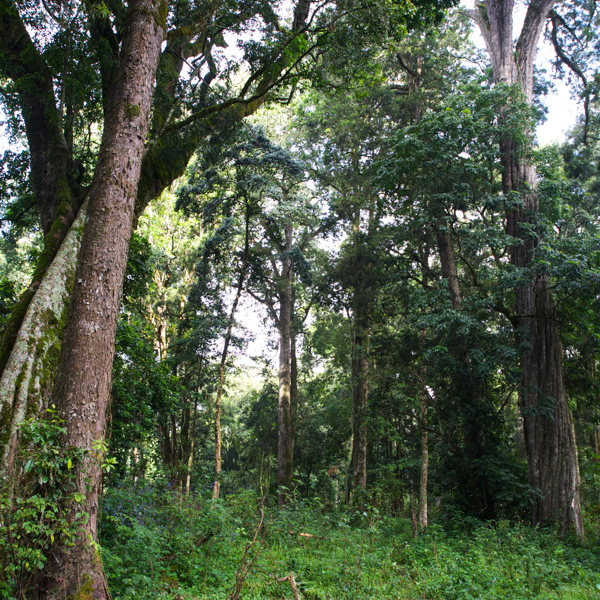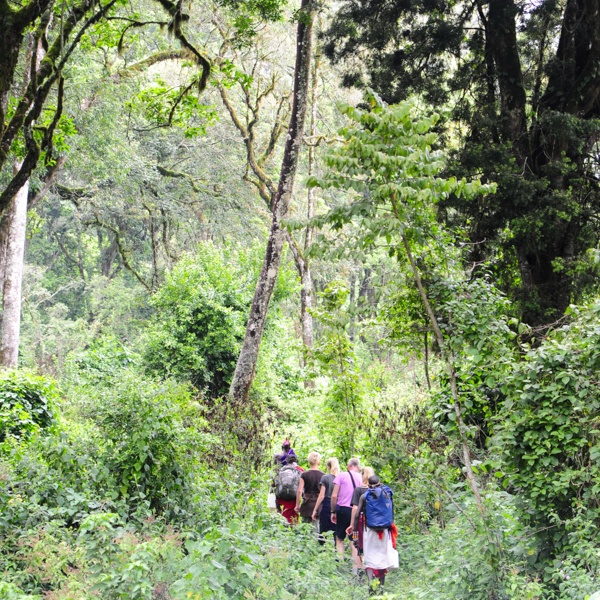
DAY 1: Karisia Hills
You will be met at the airstrip at Kisima (Maralal) and we will drive to the camp on the edge of the forest. The camp will be set up in a grassy glade looking towards a huge rock outcrop. The rest of the morning can be spent relaxing, having a shower and settling in after the flight. After lunch and a siesta we will go on an evening stroll, exploring the area, birdwatching and looking for Warthogs and the shy Bushbuck. The plains below the hills are home to the Samburu people and they graze their livestock on the edges of the forest. An evening visit to a manyatta is easily arranged. Camp at Lolkejeta
DAY 2: Karisia Hills
After breakfast we will walk up into the forest enjoying birds such as the Hartlaub’s Turaco, Silvery-Cheeked Hornbill and possibly even a Crowned Eagle. The forest is full of ancient, old-growth Podocarpus and Strangler Figs trees and we shall learn of the medicinal uses of the plants and trees by our Samburu trackers. The forest is home to Buffalo and Elephant, which we might see if we are lucky. We will have a picnic on an ancient rock outcrop used for millennium as a lookout before taking another route down to a new camp called Rapa, at the foot of the hills. In the evenings we can wander around this area and enjoy a sundowner looking out over the forest.
| Difficulty: | Moderate/Energetic |
|---|---|
| Wildlife: | Excellent |
| Landscapes: | Excellent |
| Culture: | Excellent |
| Great for Kids: | Good For Older Kids |
| Distance: | 10-12 km each day |

DAY 3: karisia hills
We will wake early and walk along the edge of the forest before dropping down into the drier country to the east of the Karisia Hills. The scenery changes dramatically and at the bottom it is much drier with a lot of Acacia Tortillis. The camels will be following along with us and they carry refreshments and snacks and can be ridden when the terrain allows. The main team will aim to get to camp ahead of us and set up so that when we arrive there is a cold beer and cool glass of wine waiting. We will camp on the Suiyan Lugga (a seasonal sand river), digging for crystal clear water for the showers and basins. Here we might see Klipspringer perched on the rocks and if we are lucky some Stone Partridges in the evening.
DAY 4: Suyan / Seya Lugga
Wake up with hot water in our basins and the morning chorus of birds and after light breakfast we will walk to the confluence of the Suiyan and Seya luggas. The Hyrax will watch us carefully as we walk by and the Go Away Birds will fly off chattering and letting animals in the area know there are people coming. Today we will walk on the sand rivers all the way to our next camp and enjoy the rock formations, fig trees growing out of crevasses and watch the livestocl come to water. The water is rarely on the surface but has to be collected from wells in the sand and the warriors sing to their cattle as they come to drink. In the evening we will go out looking for Greater Kudu who like this area. Camp on the Chanook.

DAY 5: Nantodo
We will wake up early and set off towards the river that stretches a long way below us. We will wind our way slowly down towards the river and as we go look for the glitzy. Golden Breasted Starling. We will stop for refreshments on the way and by lunchtime we will be at the Ewaso River. We will cross the river here and camp under the impressive rock outcrop called Nantodo. After an afternoon of relaxing by the river we will go on an evening walk, hunting for the noisy, but shy Stone Partridges and fantastic Verreaux Eagles who both frequent the rock faces of Nantodo
DAY 6: Nantodo
We will spend a second night in this camp and spend the day as you choose. If you are feeling energetic we can walk up Nantodo and enjoy the spectacular view as well as the varied birdlife. If you prefer to stroll along the river looking for hippo we can do this. A dip in a shallow part of the river followed by a siesta and afternoon walk to a place to enjoy gin and tonic could be the afternoon’s entertainment. Our team can also take you tracking and show you how to harvest honey.
DAY 7: Ngai Suisui
We will walk up and out of the river valley following a dry river bed with salt licks that the animals like to use. The scenery changes again entirely and the country becomes open with acacia trees. We will look out for Gerenuk, Grants Gazelle and the beautiful Grevy Zebra. Our camp is set on a ridgeline not far east of another jutting granititic pinnacle which is named Ngai suisui which means ‘winds of god’ in Samburu. The camp faces wild northern country of Kenya, making a stunning backdrop to our last sundowner and all the country that we have traversed.
DAY 8 : Travel
Travel: Note from here the closest airstrip is Kimancho but a transfer to Nanyuki or Nairobi can be easily organized.
| Includes: | Full board AirBnC accommodation on safari with all drinks included |
|---|---|
| One Night at Tumaren Camp | |
| Guides and camels for your safari | |
| Conservation & Community Fees | |
| Game drives at Tumaren | |
| Excludes: | Gratuities |
| Insurance | |
| Items of a Personal Nature |














